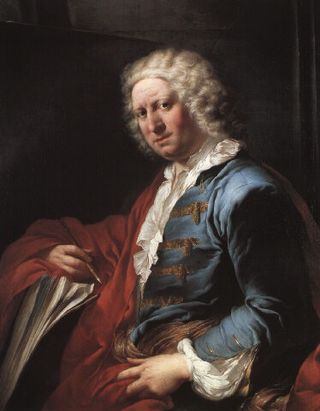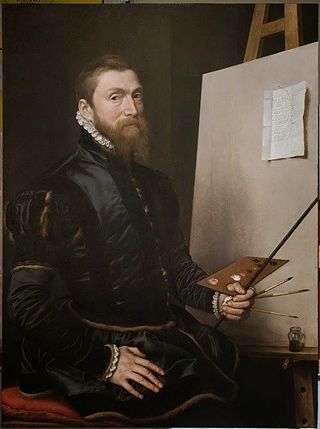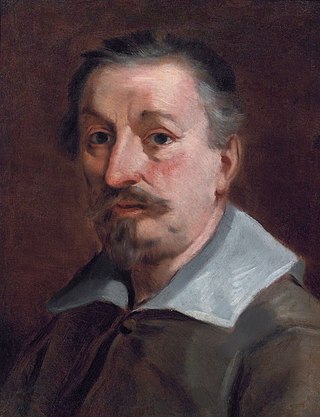
Antonio Allegri da Correggio, usually known as just Correggio was an Italian Renaissance painter who was the foremost painter of the Parma school of the High Italian Renaissance, who was responsible for some of the most vigorous and sensuous works of the sixteenth century. In his use of dynamic composition, illusionistic perspective and dramatic foreshortening, Correggio prefigured the Baroque art of the seventeenth century and the Rococo art of the eighteenth century. He is considered a master of chiaroscuro.

Anton Raphael Mengs was a German painter, active in Dresden, Rome, and Madrid, who while painting in the Rococo period of the mid-18th century became one of the precursors to Neoclassical painting, which replaced Rococo as the dominant painting style in Europe.

The Biblioteca Ambrosiana is a historic library in Milan, Italy, also housing the Pinacoteca Ambrosiana, the Ambrosian art gallery. Named after Ambrose, the patron saint of Milan, it was founded in 1609 by Cardinal Federico Borromeo, whose agents scoured Western Europe and even Greece and Syria for books and manuscripts. Some major acquisitions of complete libraries were the manuscripts of the Benedictine monastery of Bobbio (1606) and the library of the Paduan Vincenzo Pinelli, whose more than 800 manuscripts filled 70 cases when they were sent to Milan and included the famous Iliad, the Ilias Picta.

Giovanni Paolo, also known as Gian Paolo Panini or Pannini, was an Italian painter and architect who worked in Rome and is primarily known as one of the vedutisti. As a painter, Panini is best known for his vistas of Rome, in which he took a particular interest in the city's antiquities. Among his most famous works are his view of the interior of the Pantheon, and his vedute—paintings of picture galleries containing views of Rome. Most of his works, especially those of ruins, have a fanciful and unreal embellishment characteristic of capriccio themes. In this they resemble the capricci of Marco Ricci. Panini also painted portraits, including one of Pope Benedict XIV.

Anthonis Mor, also known as Anthonis Mor van Dashorst and Antonio Moro, was a Netherlandish portrait painter, much in demand by the courts of Europe. He has also been referred to as Antoon, Anthonius, Anthonis or Mor van Dashorst, and as Antonio Moro, António Mouro, Anthony More, etc., but signed most of his portraits as Anthonis Mor.

Francesco Albani or Albano was an Italian Baroque painter of Albanian origin who was active in Bologna (1591–1600), Rome (1600–1609), Bologna (1609), Viterbo (1609–1610), Bologna (1610), Rome (1610–1617), Bologna (1618–1660), Mantova (1621–1622), Roma (1623–1625) and Florence (1633).

Marcantonio Franceschini was an Italian painter of the Baroque period, active mostly in his native Bologna. He was the father and teacher of Giacomo Franceschini.
Antonio Bosio was a Maltese scholar, the first systematic explorer of subterranean Rome, author of Roma Sotterranea and first urban spelunker.
Luigi Fontana was an Italian sculptor, painter and architect.

The Palazzo Buonaccorsi is an 18th-century aristocratic palace, now the civic museum of the town, located on Via Don Minzoni 24 in the historic center of Macerata, region of Marche, Italy.

San Nicola da Tolentino agli Orti Sallustiani is a church in Rome. It is referred to in both Melchiori's and Venuti's guides as San Niccolò di Tolentino, and in the latter it adds the suffix a Capo le Case. It is one of the two Roman national churches of Armenia. The church was built for the Discalced Augustinians in 1599, and originally dedicated to the 13th century Augustinian friar Saint Nicholas of Tolentino.

Luigi Garzi (1638–1721) was an Italian painter of the Baroque period, whose work displayed heavy influences of the Bolognese painter, Guido Reni.

The Basilica of Saint Nicholas of Tolentino is a Roman Catholic church and minor basilica that is part of the Augustinian monastery in the hill-town of Tolentino, province of Macerata, Marche, central Italy. The church is a former cathedral of the Roman Catholic Diocese of Tolentino, suppressed in 1586.

Giovanni Felice Ramelli (1666–1740) was an Italian painter of the Baroque period, active mainly in Rome. He also became an abbot of the Augustinian order of Canons Regular of the Lateran.

Christopher Unterberger, also Christoph or Cristoforo was an Italian painter of the early-Neoclassical period.
Antonio Dardani (1677–1735) was an Italian painter of the Baroque period, mainly in his native Bologna..
Vincenzo Pagani was an Italian painter of the Renaissance period.

Hercules slaying Antaeus, c. 1460, is a painting by the Florentine artist Antonio del Pollaiuolo. It is small at 6 x 3 1/2 inches, painted in egg tempera on a panel of wood. It is now in the Uffizi gallery, Florence.
Carlo Vecce is Professor of Italian Literature in the University of Naples "L'Orientale", he taught also in the University of Pavia, the D'Annunzio University of Chieti–Pescara and the University of Macerata. Abroad he was visiting professor at Paris 3 (2001) and University of California Los Angeles (UCLA) (2009).

Leda and the Swan is a lost tempera on canvas painting by Michelangelo, produced in 1530, but now only surviving in copies and variants. The work depicted the Greek myth of Leda and the Swan.















